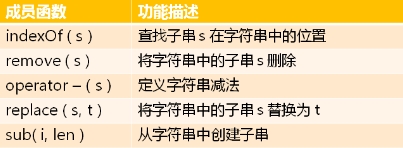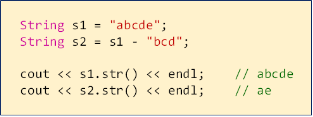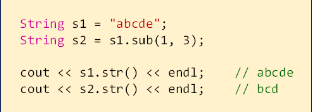作者:mobiledu2502882517 | 来源:互联网 | 2023-10-17 20:19
我们在上节博客中讲到了KMP算法的具体实现,那么我们本节就来看看KMP算法的应用。问题:如何在目标字符串中查找是否存在指定的子串? 我们来看看字符串类
我们在上节博客中讲到了 KMP 算法的具体实现,那么我们本节就来看看 KMP 算法的应用。问题:如何在目标字符串中查找是否存在指定的子串?
我们来看看字符串类中的新功能,如下图所示

1、子串查找(KMP 算法的直接应用)
int indexOf(const char* s) const;
int indexOf(const String& s) const;
我们来看看具体源码的实现,如下
int String::indexOf(const char* s) const
{
return kmp(m_str, s ? s : "");
}
int String::indexOf(const String& s) const
{
return kmp(m_str, s.m_str);
}
直接利用我们上节博客实现的 kmp 函数就能实现 indexOf 函数,我们来看看效果
#include
#include
#include "DTString.h"
using namespace std;
using namespace DTLib;
int main()
{
String s = "ababax";
cout << s.indexOf("bax") << endl;
return 0;
} 编译运行结果如下

我们看到返回的位置为下标为 3 处,也就是 s[3] 处。
2、在字符串中将指定的子串删除
String& remove(int i, int len);
String& remove(const char* s);
String& remove(const String& s);
根据 KMP 在目标字符串中查找子串的位置,再通过子串位置和子串长度进行删除。具体源码实现如下
String& String::remove(int i, int len)
{
if( (0 <= i) && (i < m_length) )
{
int n = i;
int m = i + len;
while( (n < m) && (m < m_length) )
{
m_str[n++] = m_str[m++];
}
m_str[n] = '\0';
m_length = n;
}
return *this;
}
String& String::remove(const char* s)
{
return remove(indexOf(s), s ? strlen(s) : 0);
}
String& String::remove(const String& s)
{
return remove(indexOf(s), s.length());
}
我们来写个测试代码进行测试,如下
#include
#include
#include "DTString.h"
using namespace std;
using namespace DTLib;
int main()
{
String s = "ababax";
cout << s.remove("bab").str() << endl;
return 0;
} 我们来看看结果是不是 aax,如下

3、字符串的减法操作定义(operator -)
使用 remove 实现字符串间的减法操作,必须得保证字符串自身不被修改,返回产生的新串。最后效果如下

String operator - (const String& s) const;
String operator - (const char* s) const;
String& operator -= (const String& s);
String& operator -= (const char* s);
利用原有的 + 操作符进行改装即可,源码实现如下
String String::operator - (const String& s) const
{
return String(*this).remove(s);
}
String String::operator - (const char* s) const
{
return String(*this).remove(s);
}
String& String::operator -= (const String& s)
{
return remove(s);
}
String& String::operator -= (const char* s)
{
return remove(s);
}
我们来测试下,测试代码如下
#include
#include
#include "DTString.h"
using namespace std;
using namespace DTLib;
int main()
{
String s = "ababax";
String s1 = s - "bax";
cout << s.str() << endl;
cout << s1.str() << endl;
s -= s;
cout << "[" << s.str() << "]" << endl;
return 0;
} 我们来看看运行结果,s1 = "aba", 最后的 s 应该为空,我们来看看结果

我们看到结果正如我们所分析的那样。
4、字符串中的子串替换
String& replace(const char* t, const char* s);
String& replace(const String& t, const char* s);
String& replace(const char* t, const String& s);
String& replace(const String& t, const String& s);
我们来看看具体源码的实现
String& String::replace(const char* t, const char* s)
{
int index = indexOf(t);
if( index > 0 )
{
remove(t);
insert(index, s);
}
return *this;
}
String& String::replace(const String& t, const char* s)
{
return replace(t.m_str, s);
}
String& String::replace(const char* t, const String& s)
{
return replace(t, s.m_str);
}
String& String::replace(const String& t, const String& s)
{
return replace(t.m_str, s.m_str);
}
我们来写个测试代码进行测试,代码如下
#include
#include
#include "DTString.h"
using namespace std;
using namespace DTLib;
int main()
{
String s = "ababax";
s.replace("baba", "xyz");
cout << s.str() << endl;
return 0;
} 我们来看看最后的结果是不是 axyzx,运行结果如下

5、从字符串中创建子串
String sub(int i, int len) const;
以 i 为起点提取长度为 len 的子串,子串提取保证不会改变字符串本身的状态。如下

具体源码实现如下
String String::sub(int i, int len) const
{
String ret;
if( (0 <= i) && (i < m_length) )
{
if( len < 0 ) len = 0;
if( len > m_length ) len = m_length - i;
char* str = static_cast(malloc(len + 1));
strncpy(str, m_str + i, len);
str[len] = '\0';
ret = str;
}
else
{
THROW_EXCEPTION(IndexOutOfBoundsException, "Parameter i is invalid ...");
}
return ret;
} 我们来写个测试代码进行测试,测试代码如下
#include
#include
#include "DTString.h"
using namespace std;
using namespace DTLib;
int main()
{
String s = "ababax";
String s1 = s.sub(3, 10);
String s2 = s.sub(2, 3);
cout << s.str() << endl;
cout << s1.str() << endl;
cout << s2.str() << endl;
return 0;
} 最后的结果应该是 s = "ababax" ; s1 = "bax" ; s3 = "aba" ; 运行结果如下

现在我们的字符串类已经实现的有点规模了。通过今天对字符串类的学习,总结如下:1、字符串类是工程开发中必不可少的组件;2、字符串中应该包含常用的字符串操作函数,a> 增:insert, operator + , ...; b> 删:remove,operator -,...; c> 查:indexOf,...; d> 改:replace,... 。